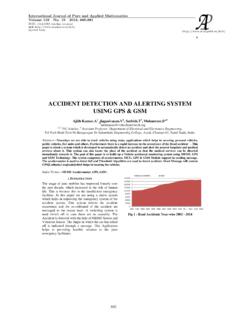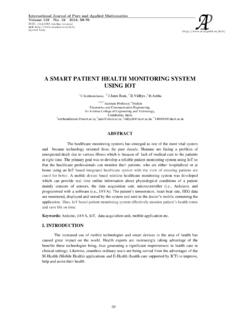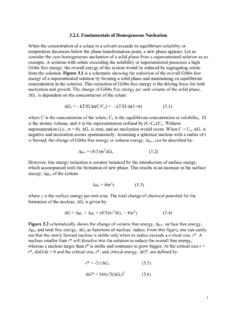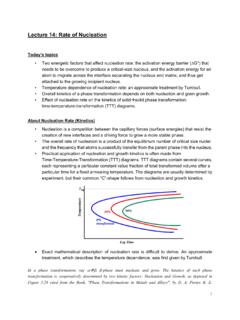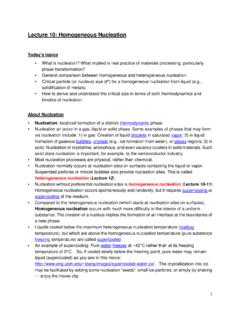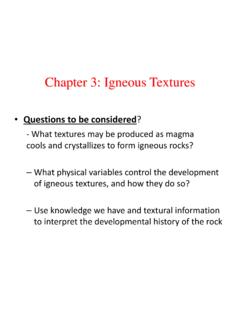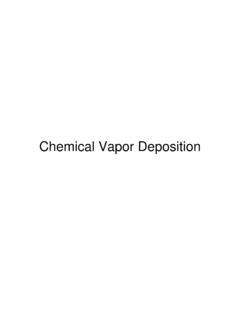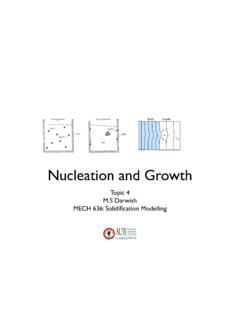Transcription of DIFFERENT TYPES OF CRYSTAL GROWTH METHODS
1 DIFFERENT TYPES OF CRYSTAL GROWTH METHODS , Assistant Professor 1 2 Department of Physics, BIST, BIHER, Bharath University, Chennai. ABSTRACT: To grow a CRYSTAL , the basic condition to be attained is the state of super saturation, followed by the process of nucleation . The information of super saturation and nucleation forms the basis of CRYSTAL GROWTH of crystals from liquid and gaseous solutions, pure liquids and pure gases can only occur if some degree of super saturation or super cooling has been first achieved in the system. The attainment of the supersaturated state is essential for any crystallization operation and the degree of super saturation or deviation from the equilibrium saturated condition is the prime factor controlling the deposition process. INTRODUCTION: Crystals are used in semiconductor physics, engineering, as electro-optic devices etc.
2 , so there is an increasing demand for CRYSTAL [1-5]. For years, Natural specimens were the only source of large, well formed crystals. The GROWTH of crystals generally occurs by means of following sequence of process. Diffusion of the molecules of the crystallizing substance through the surrounding environment. Diffusion of these molecules over the surface of the CRYSTAL to special sites on the surface. Today almost all naturally occurring crystals of interest have been synthesized successfully in the laboratory[6-9]. It is now possible only by CRYSTAL GROWTH techniques. International Journal of Pure and Applied MathematicsVolume 119 No. 12 2018, 5743-5758 ISSN: 1314-3395 (on-line version)url: The GROWTH aspect differs from CRYSTAL depending as their physics and chemical properties such as solubility, melting point[10-15], decomposition, phase change, etc,This chapter gives a brief account of the METHODS of CRYSTAL GROWTH .
3 BASICS OF CRYSTAL GROWTH : To grow a CRYSTAL , the basic condition to be attained is the state of super saturation, followed by the process of nucleation [16-21]. The information of super saturation and nucleation forms the basis of CRYSTAL GROWTH . CONDITIONS FOR GROWING CRYSTAL : The GROWTH of crystals from liquid and gaseous solutions, pure liquids and pure gases can only occur if some degree of super saturation or super cooling has been first achieved in the system[22-27]. The attainment of the supersaturated state is essential for any crystallization operation and the degree of super saturation or deviation from the equilibrium saturated condition is the prime factor controlling the deposition process. GROWTH of crystals can be considered to compress these steps[28-35]. 1.
4 Achievement of super saturation or super cooling. 2. Formation of CRYSTAL nucleus of microscopic size. 3. Successive GROWTH of crystals to yield distinct faces. CRYSTAL GROWTH TECHNIQUES: CRYSTAL GROWTH is a challenging task and the technique followed for CRYSTAL GROWTH depends upon the characteristics of the materials under investigation[36-43], such as its melting point, Volatile nature, solubility in water or other organic solvents and so on. The basic GROWTH METHODS available for CRYSTAL GROWTH are broadly. International Journal of Pure and Applied MathematicsSpecial Issue5744 GROWTH from melt. GROWTH from vapour. GROWTH from solution. GROWTH from solid. CRYSTALS GROWTH From Melt From Solid From Vapor From Solution With Crucible Without Crucible DVT HVT Low Temperature High Temperature Evaporation Slow Cooling Slow Cooling Evaporation Kyropoulds Czochralksi Verneuil Technique Floating Zone Zone Movement Dgman Stock Barge Figure.
5 1. Classification of CRYSTAL GROWTH METHODS International Journal of Pure and Applied MathematicsSpecial Issue5745 GROWTH FROM THE MELT: Melt GROWTH is the process of crystallization of fusion and resolidification of the pure material, crystallization from a melt on cooling the liquid below its freezing point. In this technique apart from possible contamination from crucible materials and surrounding atmosphere[44-50], no impurities are introduced in the GROWTH process and the rate or GROWTH is normally much higher than possible by other METHODS . Melt GROWTH is commercially the most important method of CRYSTAL GROWTH . The GROWTH from melt can further be sub-grouped into various techniques. a) Bridgmann method. b) Czochralski method. c) Vernuil method. d) Zone melting method.
6 E) Kyropoulos technique. f) Skull melting. Bridgmann method: This technique was named after its inventor Bridgemann in 1925, Stockbarger in1938. method The Bridgmann technique is a method of growing single CRYSTAL ingots or boules. The method involves heating polycrystalline material in a container above its melting point and slowly cooling it from one end where a seed CRYSTAL is located. Single CRYSTAL material is International Journal of Pure and Applied MathematicsSpecial Issue5746progressively formed along the length of the container,the process can be carried out in a horizontal or vertical geometry. Advantage: This method is technically simple. This technique is low cost. Selecting the appropriate container can produce CRYSTAL of pre assigned diameter. Disadvantage: The compression of the solid by the contracting container during cooling can lead to the development of stresses high enough to nucleate dislocations in the material.
7 Czochralski method (or) Pulling Technique: This method is widely used for growing semi conducting material CRYSTAL . The shape of the CRYSTAL is free from the constraint due to the shape of the crucible. In this method the charge is melted and maintained at a temperature slightly above the melting point. The pulling rod is lowered to just touch the melt. Since the rod is at lower temperature of melt occurs at the point tip of the pulling rod. The CRYSTAL is pulled slowly. The rate of pulling upon various factors like thermal conductivity, latent heat of fusion of charge and rate of cooling of the pulling rod. The seed is rotated to keep the grow CRYSTAL uniform and cylindrical. International Journal of Pure and Applied MathematicsSpecial Issue5747 Figure. 3 Czochralski method Advantage: This method is used to grow large single crystals.
8 Thus it is used extensively in the semiconductor industry. There is no direct contact between the crucible walls and the CRYSTAL which helps to produce unstressed single CRYSTAL . Disadvantage: In general this method is not suitable for incongruently melting compounds and of course the need for a seed CRYSTAL of the same composition limits is used as tool for exploratory synthetic research. Vernuil method: The basis of vernuils method is as follows. Chemically pure fine powder which emerges through an Oxygen-hydrogen flame and falls onto the fused end of an oriented single CRYSTAL seed fixed to a lowering mechanism. The powder charge is fed from bankeei by mean of a special tapping mechanism. Coordinating the consumption of the charge, hydrogen and oxygen with the rate of descent of the seed ensures crystallization at a prescribed level of the apparatus.
9 Advantage: There is no container which eliminates the problem of physical-chemical interaction between the melt and the container material. It is technically simple and the GROWTH of CRYSTAL can be observed. Single CRYSTAL of ruby, sapphire etc., can be grown by this method. Single CRYSTAL in various Shapes like plates, disc, hemi-sphere and cones can be grown by this method. Zone Melting Method: International Journal of Pure and Applied MathematicsSpecial Issue5748 In this technique a liquid zone is created by melting a small amount of materials in a relatively large or long solid charge. Zone melting techniques basically enable one to manipulate distribution of soluble impurities or phases through a solid. Advantage: Zone melting technique is that impurities tend to be concentrated in the melted portion of the sample.
10 The process sweeps them out of the sample and concentrates them at the end of the CRYSTAL bowl, which is then cut off and discarded. Thus this method is sometimes used to purify semiconductor crystals. Kyropoulos Technique: In this technique, a cooled seed to initiate single CRYSTAL GROWTH within the melt containing crucible. Heat removal continues by controlling the furnace temperature to grow the CRYSTAL . Technique Advantage: The CRYSTAL is grown in a larger diameter. International Journal of Pure and Applied MathematicsSpecial Issue5749 With the large diameter CRYSTAL we can make prisms, lenses and other optical components. Skull Melting Process: Skull melting process is used for the GROWTH of high melting point materials. Cubic zirconium is made using a radio-frequency Skull crucible system, a specialized melt process.


